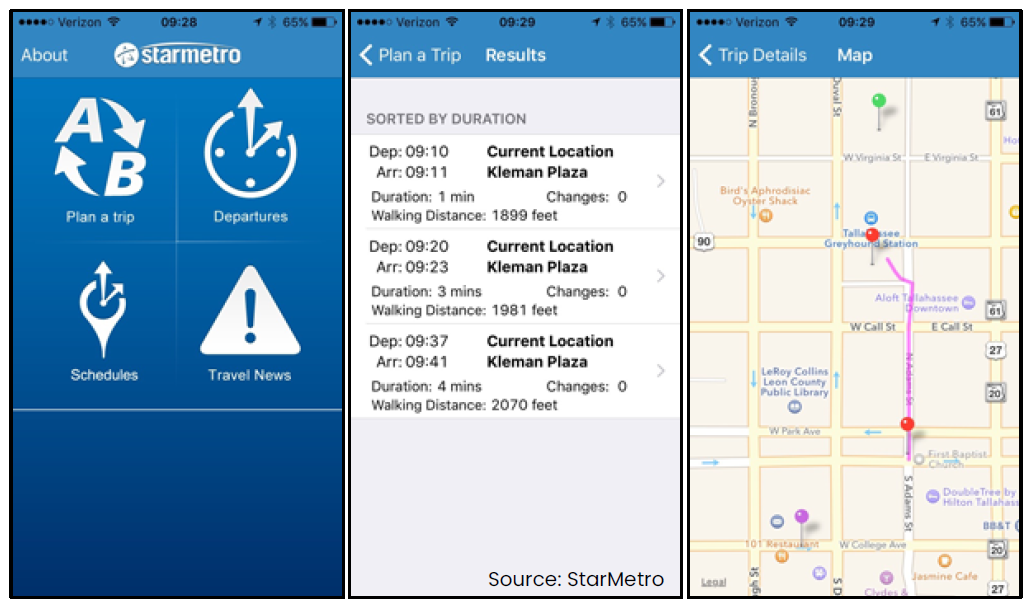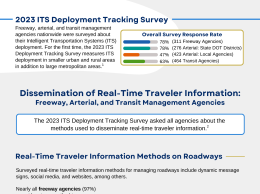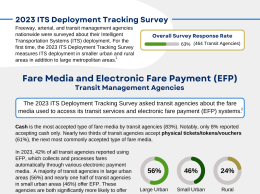2020 Executive Briefing
BRIEFING HIGHLIGHTS
- Full Integrated Fare Payments are not currently in deployment in the United States, but many agencies are working towards them.
- Allowing customers to book multiple services in one interface leads to greater usage and popularity.
- Integrating Mobile Agencies should lay groundwork for future upgrades to IFP by reviewing and consolidating their fare systems and policies.
Introduction
The term “Mobility Payment Integration” (MPI) refers to a suite of advances in fare collection that collectively work to make it easier for users to pay for multiple modes of transportation. The Federal Transit Administration (FTA) defines MPI as a multimodal implementation that provides some combination of: “a common payment media across participating services, mobile applications integrated with the mobility providers, common payment accounts, and the use of incentives or co-marketing to build ridership.” (2020-00951)
The vision of "full payment integration" is a transportation system where users are able to combine multiple different modes of transportation—such as a bus trip and an e-scooter rental—and pay for the entire journey at once with a single transaction that is divided behind the scenes between the providers. This system would include both public agencies and private transportation providers.
Many transit agencies are taking the initial steps towards this version by upgrading from simple fares and paper tickets to use contactless smart cards or bank cards, mobile applications, transit ticketing accounts, and multimodal trip planners. Agencies are also exploring novel methods of fare payment and fare adjustment, for example by using algorithmic fare adjustments to manage demand and to minimize congestion. Because of their impact on the overall road environment, transit fare policies and vehicular tolling policies affect all travelers within an area, making proper management vital.
A FTA survey conducted through January 2018 for its 2019 state of the practice assessment found 34 locations that had adopted some form of Automated Fare Collection (AFC) in their transit systems, in most cases using mobile tickets or reloadable smart cards to pay for their fares. Of these, a total of 18 locations had advanced to some more sophisticated form of MPI. Many agencies are actively working towards MPI implementations, with new deployments being rolled out all the time.
Benefits
The FTA’s Mobility on Demand (MOD) Sandbox program includes several ongoing projects that incorporate IFP models and strategies. The MOD Sandbox is a demonstration effort to explore promising new mobility concepts and technologies by providing funding to 11 pilot projects around the country. Although the efforts are in the process of finalizing their results, the pilots provide engaging insight into the future of mobility. (2020-00951)
Valley Metro Rail, Phoenix, Arizona
Valley Metro launched an app called “Pass2Go,” designed to provide travelers with easier connection to a variety of mobility providers, including ridesharing services. The app aims to support an integrated, connected, multimodal transit system by combining mobile ticketing and multimodal trip planning into a single platform. Pass2Go replaces Valley Metro’s previous app, “Ridekick.”

The project has so far completed its first phase, which deployed a basic trip planner and full-day fare mobile ticketing. The project team launched this first phase in March 2018 and ended it in December 2019. An evaluation document based on the results of this phase is still in production. The second phase is intended to expand mobile ticket purchasing options to include rideshare and carshare providers.
Preliminary Findings: Preliminary results indicate that the Pass2Go app has already resulted in a significant mode shift in travel, encouraging greater use of transit. The pilot reports that 40 percent of users have begun using bus transit more often, 50 percent reported using rail more often, and about 25 percent have begun walking more often. Travelers also reported significant improvements in the quality of the services they use, with 29 percent reporting shorter travel times. However, final results still have yet to be released.
Dallas Area Rapid Transit (DART), Dallas, Texas
| As of January 2018, 34 locations around the country had deployed Automated Fare Collection systems; of these, 18 were in the process of advancing to MPI. |
DART upgraded its “GoPass” regional mobile ticketing app, adding microtransit and dynamic carpooling services as available options for users booking trips. The service expansion was intended to improve first-mile/last-mile connections, particularly in areas that were poorly served by transit. This first phase was launched in May 2018. The second phase is intended to add rideshare providers.
Findings: All users of GoPass have reported improved connectivity to DART’s bus and rail system after the pilot program launched. Over 70 percent of users reported their approximate wait time was “good” or “excellent,” and the program had an average monthly ridership of 4,500.
Costs
In December of 2018, the San Diego Metropolitan Transit System procured a new fare payment system in order to replace its existing system, which had transitioned from paper fare products to an electronic collection system in 2009. It found that the existing “Compass Card” system was reaching the end of its “useful life,” requiring high levels of equipment maintenance and parts replacements in order to keep the system functioning. (2020-00450)
The new system, which is still in the process of being implemented, emphasizes mobile ticketing and will be account-based, allowing users flexibility in payment media. Account-based systems are typically considered a first-step towards greater IFP deployment, as they allow agencies to be well-positioned to expand and update services. The fare system will also institute fare-capping, which automatically determines the most efficient fare product for a usage profile and ensures that travelers are not penalized for not purchasing the most efficient fare product upfront. MTS also expressed an intent to expand payment media to include contactless bank cards, which—owing to their universality—can be considered a form of IFP.
Project costs, according to Metropolitan Transit System data, are summarized in the table below.
| Item | Amount |
|---|---|
| Program and Contract Management | $1,803,996.54 |
| System Software and Design | $3,516,293.72 |
| Equipment | $15,491,012.72 |
| Testing | $679,845.15 |
| Installation | $1,549,938.20 |
| Training and Manuals | $184,331.69 |
| Total Capital Costs | $23,225,418.02 |
| Operations and Maintenance | $8,374,419.69 |
| System Hosting | $2,629,896.25 |
| Total Operating Costs | $11,004,315.94 |
| Exceptions and Alternatives | $70,070.00 |
| Total Cost for Base Period | $34,159,663.96 |
Best Practices
The FTA State of the Practice assessment identified major challenges faced by agencies seeking to update their service and offered recommendations to meet them (2020-01446):
- Fare Simplification. Many transit agencies have had their fare structures become more complex over the years, which can be confusing to customers. As services change and route-specific costs increase or decrease, it can become difficult for customers to know exactly how much their ride will cost. Developing a simplified formula to calculate fares is helpful, though an intensive effort that requires several rounds of public outreach and feedback to ensure that the new formula is appropriate and reasonable. Agencies should investigate whether fare simplification would be worth the effort.
- Fare Capping. As of the publication of the report in October 2019, fare capping had only been instituted in one system in the United States (Portland, Oregon), but was substantially more popular in European countries. Interviewees in the report noted that it can be difficult for riders to become comfortable with fare capping. The assessment recommended careful, intensive public education to explain and build trust in the system.
- Cash Options. There is a general movement towards cashless business and services, often because cash transactions are seen as inefficient. However, agencies must be careful that they do not effectively bar riders without bank cards from their services; many Americans are under- or un-banked and primarily use cash for their day-to-day transactions. One method of addressing this concern will be implemented by the MBTA, which has set a standard that 95% of customers must be able to use cash within 1,000 feet of any MBTA stop.
The MOD Sandbox Demonstration Program distributed $8 million in funding to transit agencies in order to conduct research on new service options that would help enable FTA’s vision of integrated, traveler-centric transportation. Cybersecurity. Agencies accepting online
payments must be aware of the risks of data breaches. A study referenced in the assessment noted that the vast majority of users would revert to using cash for their mass transit payments in the wake of a data breach. Agencies should "stress test" their assumptions regarding the needed number of fare cards available to the public for such eventualities.
Case Study
StarMetro, the transit system of the Tallahassee, Florida metro area, implemented a mobile ticketing app called Token Transit in 2017, and piloted it until March 2018. The University of South Florida Center for Urban Transportation Research completed an evaluation report in June 2018 for the Florida Department of Transportation (FDOT) to assess the outcome of StarMetro’s deployment effort. The researchers had previously completed a primary report in spring 2016 to review existing mobile fare payment systems and to provide a recommendation to the state. The review of the second phase—the app’s deployment—includes an evaluation of an internal beta test by staff members and a public testing of the app by bus riders. It also included an assessment of survey results of public users and an evaluation of staff satisfaction with the app. (2020-00955)
Findings
- The evaluation recommends conducting an initial pilot as part of a commitment to a permanent deployment, rather than as a temporary test. This avoids discontinuing services to customers that have grown accustomed to it, which may be unpopular with riders.
- StarMetro found that its free WiFi points, which were intended to provide connectivity at bus stations and onboard vehicles, interacted in unexpected ways with the pilot technology. Customers whose devices automatically connected to available WiFi, for example, would not be able to automatically pass through the “captive portal” requiring agreement with StarMetro’s Terms of Service. This meant that the portal would deny them a WiFi connection, which effectively left the devices without a valid internet connection. This inadvertently served to make Token Transit less secure, as it was easier to bypass security mechanisms when the app could not connect to the internet.

Figure 2: Screenshots of the StarMetro app. Source: StarMetro The use of an “off the shelf” fare payment app allowed StarMetro to choose an app that had already been thoroughly tested. FDOT’s report concluded that this likely led to an overall smoother experience than an in-house app might have had. The off-the-shelf option also worked particularly well for StarMetro as it is a relatively small transit agency with no unusual circumstances or fare structures that might necessitate a bespoke solution.
- Survey results indicated that users strongly preferred seeing information within a single app. FDOT’s report recommended that agencies require APIs and deep links in proposal responses, as these allow greater flexibility in integration.



